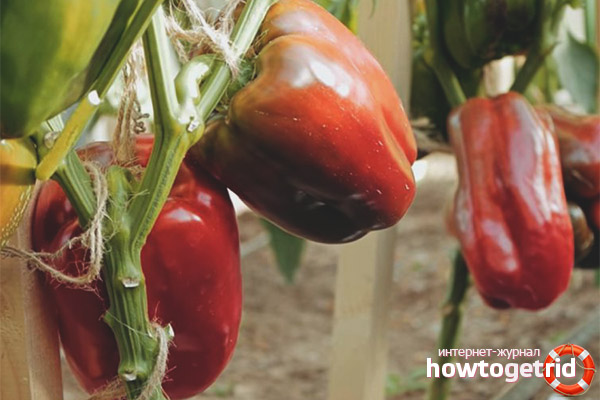The content of the article
Livadia F1 pepper is a large-fruited mid-season hybrid. The fruit mass reaches 250 g, the color in the state of biological ripeness is red, the skin is glossy. The fruit is slightly elongated, conical in shape. The bush is tall, up to 120 cm, the plant is well leafy.
Description
Lecho is prepared from this variety, sauces, fruits are stuffed, frozen, used to decorate dishes. The walls of the fetus are fleshy, up to 2.5 mm thick. Seeds in the seed chamber ripen a small amount. The hybrid is resistant to apical rot, has good preservation after a break from the bush. Fruits are well transported over long distances. The fruits of Livadia pepper will decorate any vegetable counter, will attract the attention of even the most sophisticated buyer.
Growing seedlings at home
You can grow seedlings of bell pepper in the apartment. First of all, you need to take care of high-quality seed. Buy hybrid seeds only from trusted manufacturers, in specialized seed and online stores.
Before sowing, check the germination of seeds, treat them with a growth stimulator and a weak solution of potassium permanganate.
Soil for pepper use light, structured, crumbly. It can be purchased at the store or prepared independently. To do this, take chernozem, leaf litter, peat, humus, river sand, a handful of ash.
Sow seeds in boxes or pots. It is not necessary to make a deep seeding of seeds, it is enough to deepen them by 0.5 cm. The deeper the seeds are in the soil, the longer the germination process will last.
Bell pepper loves heat very much, at an air temperature of 24 degrees shoots appear on the 5th day. At the punching stage, light is not needed, but as soon as the first whitish loops of seedlings appear, move the box with seedlings closer to the light.
Pepper seeds are sown in March. Do not rush to sowing in the hope of obtaining a quick harvest. The fact is that in February and January the daylight hours are short. Seedlings without additional lighting turns out to be unviable, elongated, yellow. Such plants will not bring a good harvest. Elongated painful seedlings take root for a very long time, tolerate transplantation extremely poorly, and are ill for a long time.
Water the seedlings only with warm water through a strainer or spray bottle. Immediately after emergence, cover the plants with glass or plastic wrap to create greenhouse conditions. Do not forget to periodically ventilate the plants. If this is not done, then a black leg disease may appear.
Bell pepper does not like drafts and excessive waterlogging. Stagnant moisture can trigger an outbreak of fungal diseases and rotting of the root system. This plant is better to underfill than to overfill.
The first top dressing of seedlings is recommended to be carried out 2-3 weeks after emergence. First of all, plants need nitrogen fertilizers. Use urea or ammonium nitrate.
At the age of 35 days, seedlings are dived into separate pots. Diving is an important procedure. In the process of picking, the tip of the root is pinched, from which the root system becomes fibrous. Do not let seedlings grow for a long time in one container. Plants in the same pot will soon begin to compete with each other for sunlight, food and water.
Avoid direct sunlight on young seedlings. Uncooked pepper leaves may suffer from sunburn.
Pepper planting in open ground
Before planting, add humus and fertilizer to the wells, water the soil liberally.
Try to take seedlings out of the pots very carefully. The fact is that pepper roots do not tolerate transplantation, take root for a long time.
Immediately after transplanting seedlings, pour it with warm water under the root or in the furrows.
Secrets of getting a big crop
In order to get large fruits, you should correctly form a bush, remove stepsons, cut off the lower leaves that are in contact with the soil.
Fruits must be removed in a state of technical ripeness, without waiting for complete biological maturation. This technique will increase the yield. The fact is that the laying of buds of bell pepper occurs in a wave-like manner, cutting off the fruits, you stimulate the formation of a new ovary.
Pepper is responsive to organic fertilizers. Feed the bushes during flowering with herbal infusion and phosphate fertilizers.
Video: pepper Livadia F1










Submit